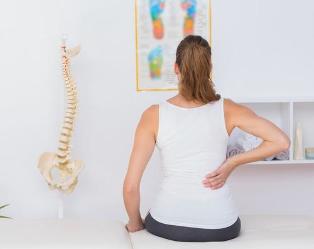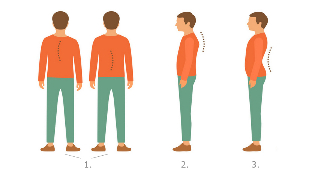Under proper posture is the ability of a person to keep your body in a straight position relaxed, not straining all his muscles. Each of us standing and sitting in a certain position, the adoption of which occurs out of habit. How direct is this physiologic position, and determines the degree of "correct" posture.

The basic formation of posture occurs in childhood, but this does not mean that an adult cannot fix your posture, get rid of her violations and achieve the correct body position. In addition, the "spoil" your posture is possible and in adulthood: for example, sedentary work and small mobile lifestyle. Curvature of the spine can lead to painful sensations and diseases, and also cause deterioration of appearance of the person.
Causes and consequences of poor posture
In a normal spine has physiological curves in the lumbar and thoracic. However, these curves can be broken, strengthened, smoothed.
The main reasons for such problems include the following:
- birth injuries;
- uncomfortable desks and too heavy backpacks during the period of school;
- the fall in early childhood, led to the production of low value injury;
- abnormal gait and posture in childhood, which is not controlled and not corrected parents/teachers;
- lack of physical activity, which cause weakening of the muscular corset;
- long maintaining poor posture (mostly in the performance of job duties);
- uncomfortable, poorly selected clothes and shoes forced to take the incorrect position of the body;
- oncological, infectious and other diseases affecting the condition of the spine;
- a variety of injuries.
The consequences of incorrect posture can be divided into several types:
- Scoliosis – lateral curvature of the spine recorded in the frontal plane.
- Kyphosis – curvature of the spine in the thoracic spine in the backward direction in the sagittal plane.
- Lordosis – curvature of the spine in the lumbar spine forward in the sagittal plane.

As already noted, problems with posture often take root in childhood. And not the last role played in this school backpacks, which the kids are forced to wear every day. Doctors have found that in order to carry portfolio did not affect the child's spine, his weight should not exceed 10-15% of the weight of the baby.
In addition, incorrect posture often cause degenerative diseases, which lead to reduced mobility, pain, and even disorders of the entire musculoskeletal system. We are talking about osteoarthritis, osteoarthrosis, and between the vertebral hernias.
If to speak about the aesthetic consequences of improper posture, we can note the hunched silhouette, concave inside the chest is convex and therefore visually more voluminous abdomen, and many other unpleasant changes in the appearance of the person.
What should be the correct posture
To check whether you have correct posture, is quite simple. Lean against the wall back and note the position of the heels, calves, buttocks, shoulder blades and neck. All these body parts must simultaneously come into contact with the wall, and you don't have to put in the effort, straining the muscles in order to achieve this effect. Otherwise, you can say that you have incorrect posture.
Another simple test is to ask someone to do your shot from behind. Then on the resulting pictures draw straight line on three lines: the ankles, pelvis and shoulders. These three traits must be parallel to each other, otherwise you can speak about the presence of curvature.
The main features are correct, physiologically correct posture include the following:
- Taut, flat stomach. Of course, the appearance of the stomach depends on the people's Constitution, however, the correct posture always makes us visually more slender in this area.
- A slight bulge in the chest area. To not do the "chest out" or, conversely, to align your spine as if her stiff Board. Correct posture necessarily includes a slight natural curves of the spine.
- The vertical position of the head.
- Laid back and a little laid down his shoulders. It does not reduce the blades or too to raise the shoulders as it is, again, unnatural for our spine.
- A slight twist of the legs at the knees, light, flying gait.
Use proper posture
- improving the functioning of many internal organs and systems and, consequently, improve overall health;
- withdrawal discomfort, pain in upper body (back, shoulders, neck);
- prevention of scoliosis, osteoporosis and other diseases that make a person unattractive and undermine his health;
- preventing the formation of so-called "beer belly", which is not insured, even people of light complexion;
- improved mental focus, concentration;
- increase self-esteem, healthy self-confidence which is so necessary for us to achieve the goals.
Biggest enemy of good posture is shoes high heels. Walking in such shoes will inevitably cause the change of the inclination of the body, which leads to violation of posture and even the appearance of systematic pain in your lower back. And those women who regularly wear high heels, can, over time, and does earn herniated discs.
Simple exercises to improve posture
As already mentioned, bad posture is not a death sentence even for an adult. It is quite possible to adjust, and on their own, using simple and clear exercises. They are suitable for those who have deviation from the correct position of the spine, has not yet turned into a serious chronic illness like scoliosis. Otherwise, improve posture it is also possible, but already in the framework of the special medical complexes.
Starting position for the first group of exercises – the same as when checking the correctness of posture. Lean against the wall so that your heels, calves, buttocks, shoulders and the back of the head at the same time touched her (for a person with impaired posture maintaining such position requires muscular effort).
Taking such a position, follow these steps:
- Just keep the pose for three to five minutes.
- Keeping all the above points of contact of your body with your back, alternately lift the legs, bending them at the knees. Perform this exercise 10 times for each leg.
- Perform in turn tilts right and left (10 times in each direction), trying not to break the contact of the heels, calves, buttocks, shoulder blades and the nape of the neck to the wall.
- Squat against the wall, keeping all the upper point of contact of the body with the wall. In other words, you have to kinda "slide" down the wall, and then the same way up. 10 repetitions of exercises will be enough.
A good way to correct posture is swimming. When a person is in the water, the gravitational load on his spine is greatly reduced. Thanks to this strengthened muscular frame spine, improves the tone of the muscles near the vertebra, and muscles of the back and chest. All this has a beneficial effect on posture.
If you are keen to achieve a significant improvement in posture, then do not be amiss to strengthen the muscular frame.
Very useful for this next exercise:
- regular push-UPS;
- the preservation of the position of "plank" for 30-60 seconds ("strap" refers to the retention body in a straight position while resting only on your toes and forearms);
- exercise "boat" (the simultaneous lifting of both arms and both legs from a prone position on the abdomen);
- hold a dumbbell in the raised and straight arms at shoulder level (the exercise is performed in the sitting position, hold a dumbbell it should be 5-7 seconds per lift).

























